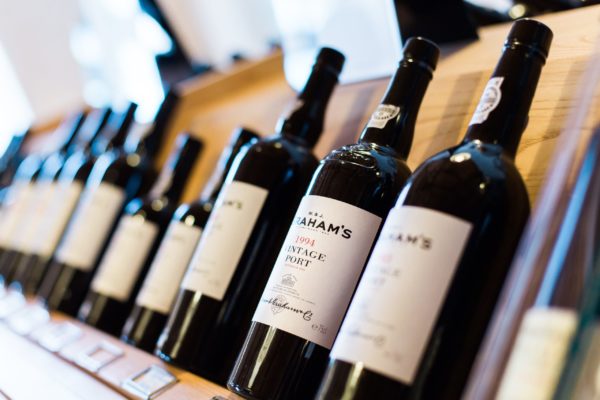Port wine is named after Portugal, its country of origin. It’s a sweet, fortified red wine that is extremely popular all around the world. But how is Port actually made? What is the wine used for? What does it actually taste like?
Let’s learn all about the history of Port wine, tell you exactly how it’s made, and tell you everything else you need to know about Portugal’s popular fortified wine.
What is Port Wine?
Port is a very sweet, fortified red wine produced in the Duoro Valley region of Portugal but enjoyed worldwide. For those who don’t know, fortified wine is a wine that includes some kind of distilled spirit to boost the alcohol content. Winemakers can control how sweet or dry their fortified wine is by adding the spirits earlier or later in the process. In the case of Port, spirits are usually added early, which kills the yeast and stops the fermentation, so the residual grape sugar results in a sweeter wine.
Port has specific regulations it must follow to truly be called “Port.” Similar to the way Champagne must come from the Champagne region of France, Port can only be labeled Port if it comes from Douro Demarcated Region, which includes Porto City and the Entreposto of Gaia. The soil, climate, and grape-growing conditions are all strictly specified to ensure that only the best vineyards produce the world’s Ports.
There are a variety of different styles of Port. There are two main categories of Port: wood-aged and bottle-aged. There are many different styles within those two categories, from red to white, rosé, and an aged style called Tawny Port. Red Port and Tawny Port are the two most popular.
Port Wine history
The British actually played a large role in the development of Port wine. Because Britain wasn’t suitable for growing grapes, the English traditionally imPorted their wine from France. But during wars with France in the 17th and 18th centuries, Britain boycotted French wine and turned its sights elsewhere.
According to legend, Port wine was actually first made by accident when grape brandy was added to a wine to keep it fresh during shipment. The wine began being shipped in oak barrels and picking up an oaky flavor, becoming extremely popular. Over the next few centuries, the English would perfect Port production, and the winemaking relationship between Portugal and England still exists today. Many Ports still have English-sounding names, such as Cockburn.
In 1703, the Methuen Treaty was signed, reducing the taxation of Portuguese wines and making Port even more popular. In 1756, Port wines from the Duoro region were demarcated, which means their quality was protected, and winemakers had to follow strict regulations. Traditionally, the farmers and landowners of the vineyards were Portuguese, and then the British would buy the wines from them, age them in Port, and handle the export business.
In the late 19th century, an American root insect called phylloxera, which smuggled itself to Portugal in humid, speedy steamboats, devastated the Portuguese wine industry. The effects of phylloxera can still be seen in the Duoro valley today, in the form of “dead” terraces that were treated with harsh chemicals that contaminated the soil, rendering it no longer suitable for grape growing. Over time, phylloxera-resistant American plants began to be planted, and the industry got back up and running.
Today, a huge variety of ports are being produced in Portugal, ranging from inexpensive to luxurious. There is also a huge variety of Port-style wines being produced worldwide, but they aren’t allowed to be labeled as such if they don’t hail from Portugal. Port is a rare type of wine because it’s both sweet and red, uncommon to come across.
How is Port made?
There are some newer, more modern methods of making Port, but the traditional method is still widely used. This method uses lagars, shallow, open vats, to crush the grapes and intensify the color extracted from the grape skins. The use of lagars is an ancient winemaking technique and is rarely used in other parts of the world.
The grapes for Port wine are also still picked by hand. Other parts of the process have been mechanized, from automated lagars to machines that destem the grapes. However, since the ancient terraces are protected and too narrow for tractors, the grapes must be harvested manually.
Once the grapes are picked, they go into the large granite lagars, where they are crushed. The crushing process is either done by machine, or in some cases, by foot. This process can take up to three days. After the grapes are crushed, the wine is transferred into fermentation tanks, where it continues to ferment until the optimal sugar level is reached.
The fermentation is stopped early to save some residual sugar from the grapes and keep Port sweet. At this point, brandy is added to stop the fermentation process and up the ABV%. Most Ports are about 30%, but they must reach the legal minimum ABV%, which is 17.5%.
At this point, the Port is aged. By law, all Ports must age at least two years before being sold. The aging process is what differentiates the different varieties of Port. Vintage Port is aged for two years in a barrel, then bottled, but is meant to age between 10-50 years in the bottle. Late Vintage Port is aged for four to six years in the barrel and then bottled. Tawny Port can be aged around three years in barrels, but most varieties are aged 10-40 years.
What does Port taste like?
In general, Port is usually very sweet and is drunk as a dessert wine. There are a variety of different colors and types of Port, each with its own distinct flavors.
Ruby (Red) Port
Ruby or Red Port is a deeply colored red Port with a clean, full-bodied flavor palette. The flavor notes are usually fruitier, including plum jam, blackberry, black currant, licorice, and chocolate. Ruby Port spends less time than tawny Port in barrels, which helps preserve some of its wine-like characteristics, like the intense color, the fresh body, and the full body. Red Ports can include Vintage, Late Vintage, Crusted, and Ruby Ports.
Great bottles include Ramos Pinto Vine Ruby Porto, Dow’s Fine Ruby Port, and Sandeman Founders Reserve Port.
Tawny Port
Along with Red Port, Tawny is one of the most popular varieties of this type of wine. Tawny Port is very sweet and spends much longer aging in the barrel than Red or Ruby Port. Since it ages so long in the barrel, it begins to oxidize slightly and takes on flavors of nuts, caramel, mandarin orange, dried fig, praline, and beef jerky.
Wonderful bottles include Cockburn’s Tawny Porto 10 Year, Sandeman Porto Tawny 10 Year, and Dow’s Fine Tawny Port.
White Port
While less popular than Tawny Port or Ruby Port, White Ports do exist. Made with white grapes indigenous to Portugal, such as Rabigato, Viosinho, Gouveio, and Malvasia, White Port is very sweet and medium-full bodied. The flavor notes usually include spiced pear, almond, honey, and vanilla.
Lovely bottles include Fairbanks White Port and Ramos Pinto White Porto.
Rosé Port
Rosé Port is a fairly new style of Port that is quickly gaining popularity. Rosé Port is made just like Rosé wine and is often considered a less intense version of a Ruby Port. Rosé Port has a distinctive pink hue, typically has flavors of cherry, raspberry, strawberry, and caramel.
Great Rosé Ports include Croft Pink Port and Porto Valdouro Rosé.
How should Port be served?
Port makes a great after-dinner drink and can be served as dessert or alongside it. It can also be served as an aperitif, as it contrasts well with salty or pungent foods like bleu cheese. Port should ideally be served slightly chilled and around 55 to 60 degrees F. Since Port is far more alcoholic than regular wine, be sure to serve your guests a smaller Portion than you usually would.
The takeaway
Port is a deliciously sweet dessert wine with a long, rich history. Port must follow strict quality standards and regulations, so you really can’t go wrong with it, whether you’re buying a $15 bottle or a $1000 bottle. There are so many different varieties and styles of Port out there, so you’d better get to work trying them all.
To get a bottle of Port delivered straight to your door, count on Saucey. We offer a huge variety of wines, including tons of Ports and beers, and other spirits. Plus, we provide speedy delivery and absolutely no order minimums. Get exactly what you want without having to get up off the couch.




